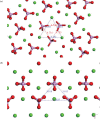A review of protein adsorption on bioceramics
- PMID: 23741605
- PMCID: PMC3363020
- DOI: 10.1098/rsfs.2012.0012
A review of protein adsorption on bioceramics
Abstract
Bioceramics, because of its excellent biocompatible and mechanical properties, has always been considered as the most promising materials for hard tissue repair. It is well know that an appropriate cellular response to bioceramics surfaces is essential for tissue regeneration and integration. As the in vivo implants, the implanted bioceramics are immediately coated with proteins from blood and body fluids, and it is through this coated layer that cells sense and respond to foreign implants. Hence, the adsorption of proteins is critical within the sequence of biological activities. However, the biological mechanisms of the interactions of bioceramics and proteins are still not well understood. In this review, we will recapitulate the recent studies on the bioceramic-protein interactions.
Keywords: bioceramics; interface; protein adsorption.
Figures





Similar articles
-
Regulation of immune response by bioactive ions released from silicate bioceramics for bone regeneration.Acta Biomater. 2018 Jan 15;66:81-92. doi: 10.1016/j.actbio.2017.08.044. Epub 2017 Aug 30. Acta Biomater. 2018. PMID: 28864248
-
Mediation of biomaterial-cell interactions by adsorbed proteins: a review.Tissue Eng. 2005 Jan-Feb;11(1-2):1-18. doi: 10.1089/ten.2005.11.1. Tissue Eng. 2005. PMID: 15738657 Review.
-
A review of chemical surface modification of bioceramics: effects on protein adsorption and cellular response.Colloids Surf B Biointerfaces. 2014 Oct 1;122:823-834. doi: 10.1016/j.colsurfb.2014.07.029. Epub 2014 Jul 24. Colloids Surf B Biointerfaces. 2014. PMID: 25092582 Review.
-
Bone extracts immunomodulate and enhance the regenerative performance of dicalcium phosphates bioceramics.Acta Biomater. 2019 Apr 15;89:343-358. doi: 10.1016/j.actbio.2019.03.012. Epub 2019 Mar 8. Acta Biomater. 2019. PMID: 30853609
-
"Hard" ceramics for "Soft" tissue engineering: Paradox or opportunity?Acta Biomater. 2020 Oct 1;115:1-28. doi: 10.1016/j.actbio.2020.08.014. Epub 2020 Aug 17. Acta Biomater. 2020. PMID: 32818612 Review.
Cited by
-
Bioactive Carbon-Based Hybrid 3D Scaffolds for Osteoblast Growth.ACS Appl Mater Interfaces. 2018 Dec 19;10(50):43874-43886. doi: 10.1021/acsami.8b13631. Epub 2018 Dec 4. ACS Appl Mater Interfaces. 2018. PMID: 30395704 Free PMC article.
-
Proteomics reveals differential adsorption of angiogenic platelet lysate proteins on calcium phosphate bone substitute materials.Regen Biomater. 2022 Jul 5;9:rbac044. doi: 10.1093/rb/rbac044. eCollection 2022. Regen Biomater. 2022. PMID: 35936551 Free PMC article.
-
Regulating Blood Clot Fibrin Films to Manipulate Biomaterial-Mediated Foreign Body Responses.Research (Wash D C). 2023 Sep 15;6:0225. doi: 10.34133/research.0225. eCollection 2023. Research (Wash D C). 2023. PMID: 37719049 Free PMC article.
-
Mesoporous Bioactive Glasses in Cancer Diagnosis and Therapy: Stimuli-Responsive, Toxicity, Immunogenicity, and Clinical Translation.Adv Sci (Weinh). 2022 Jan;9(2):e2102678. doi: 10.1002/advs.202102678. Epub 2021 Nov 19. Adv Sci (Weinh). 2022. PMID: 34796680 Free PMC article. Review.
-
Stereocomplexation Reinforced High Strength Poly(L-lactide)/Nanohydroxyapatite Composites for Potential Bone Repair Applications.Polymers (Basel). 2022 Feb 8;14(3):645. doi: 10.3390/polym14030645. Polymers (Basel). 2022. PMID: 35160634 Free PMC article.
References
-
- Dorozhkin S. V. 2010. Bioceramics of calcium orthophosphates. Biomaterials 31, 1465–148510.1016/j.biomaterials.2009.11.0 (doi:10.1016/j.biomaterials.2009.11.0) - DOI - DOI - PubMed
-
- Best S. M., Porter A. E., Thian E. S., Huang J. 2008. Bioceramics: past, present and for the future. J. Eur. Ceram. Soc. 28, 1319–132710.1016/j.jeurceramsoc.2007.12.001 (doi:10.1016/j.jeurceramsoc.2007.12.001) - DOI - DOI
-
- Williams D. F. 2009. On the nature of biomaterials. Biomaterials 30, 5897–590910.1016/j.biomaterials.2009.07.027 (doi:10.1016/j.biomaterials.2009.07.027) - DOI - DOI - PubMed
-
- Allan B. 1999. Closer to nature: new biomaterials and tissue engineering in ophthalmology. Br. J. Ophthalmol. 83, 1235–124010.1136/bjo.83.11.1235 (doi:10.1136/bjo.83.11.1235) - DOI - DOI - PMC - PubMed
-
- Doremus R. H. 1992. Bioceramics. J. Mater. Sci. 27, 285–29710.1007/BF00543915 (doi:10.1007/BF00543915) - DOI - DOI
Grants and funding
LinkOut - more resources
Full Text Sources
Other Literature Sources
Research Materials

